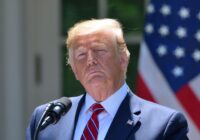The US has not invested properly in the education and reeducation that would support the development of advanced intellectual resources and capital.
With the rise of alt-right politics in Europe and the United States, along with the election of Donald Trump, some argue that the era of neoliberalism has come to an end. Those who advocate this idea claim that neoliberalism as a political and economic doctrine and belief has paved the way for much of the generated and existing imbalances and displacements in the world economy and in the US. Does neoliberalism come to an end?
Similar to classical liberalism and liberalism, neoliberalism was developed as an approach to politics and economics in the late 19th century. Its origin dates back to the French economist Charles Gide. In the 1960s, Milton Friedman reacted to Keynesianism, which was the post-World War II dominant economic paradigm encouraging a more active role for government in the economy, by a more “monetarist” approach to economic policy. Today, Friedrich Hayek, Milton Friedman and Robert Nozick are identified with the various limbs and rationalizations for neoliberalism and how it should be understood and intellectualized.
DONALD TRUMP ON INTERNATIONAL TRADE
The Republican Party has fully subscribed to neoliberalism. Ronald Reagan and Margaret Thatcher are considered the torch bearers of neoliberalism in America and Europe. The Republican Party has always been for small government, extensive tax cuts and less regulation, and has promoted self-regulating free market economies and unrestricted international trade. Trump, too, has pledged to the tenets of neoliberalism and concurrently promoted nativism and exclusive nationalism, which has given a new coloring to his neoliberalism.
The only area in which Trump might be conflicted in his neoliberalism is international trade. Although it is not presently palpable how much he can change in this area, the president-elect is intent on returning to some kind of “mercantilism.” Mercantilism was the dominant trade theory in Europe from the 16th to 18th centuries. Mercantilists believed that the amount of wealth in the world is permanent, and consequently nations must strive to accumulate as much wealth as possible. They sought their commercial interests by imposing tariffs on imports and encouraging exports.
In his business approach to government, Trump has argued in favor of the government negotiating terms of trade. He has also proposed imposing tariffs on imports to the US. Trump’s approach to international trade can face three challenges.
First, after the General Agreement on Tariffs and Trade (GATT), the World Trade Organization (WTO) was created to shift the attention to a multilateral approach to trade negotiations in order to eradicate impediments to international trade. Trump is recommending a mostly bilateral approach, case-by-case, in trade negotiation.
Second, international trade under the new norms is not a zero sum game, but beneficial to all who participate in it.
Third, in the arena of international commerce, governments must encourage the free flow of trade and not hinder it. The WTO has established norms for the negotiation of terms of trade among nations, but not between individual governments negotiating for specific business or industry.
Since Woodrow Wilson, both Republicans and Democrats have always stood for international trade. One of the causes of the Great Depression in the US was the imposed high tariff on imports, which impeded American exports. International trade has both benefits and risks, and governments should develop strategies to take advantage of the former and mitigate the latter.
WEALTH INEQUALITY IN AMERICA
Concentrating on international trade cannot alleviate the problems the American economy is facing today and offer a sense of comfort and security to the portion of the population who voted for Trump. There are at least two other areas and problems that can effect a sense of insecurity for many in the country. First, the US has the highest gap among the rich, the poor and the middle class, and the most extreme wealth concentration compared to the other top industrialized countries in the world. Second, the US economy has transformed into a “knowledge economy” over the last three decades, and many with no or less education have been left behind.
The wealth gap in the US has increased consistently in the last couple of decades. Wealth is measured based on marketable assets that include real estate, stocks, bonds, durables and household items. Financial wealth is an individual’s net worth.
In 2012, Edward Wolff of New York University indicated that in 2010, the top 1% of the American population owned 35% of all privately held wealth, while the other 19% owned 53.5%. Furthermore, the top 20% of the population in the US owned 89% of the wealth in the country. The bottom 80% of Americans owned the rest: 11% of the wealth. One percent of the population in the country had a greater share of the financial wealth: 42.1%. In terms of financial wealth for this group, 35% of privately held stock belongs to them, 64% of the financial securities and 62% of business equity.
In 2016, the Congressional Budget Office (CBO) published the numbers for the 1989-2013 period. According to the CBO, families in the top 10% of wealth distribution held 76% of all wealth, while 51% to 90% of the population held 23% of the family wealth, and those in the bottom half of the distribution held 1%. For the top 10% of the population, the average wealth was $4 million. For the 51% to 90% of the population, the average wealth was $316,000. For the 26% to 50%, it was $36,000 and for the bottom 25%, there was $13,000 debt, negative asset.
 There is also a significant difference in holding wealth by various age groups in this country. In 2013, the average wealth accumulated by families headed by someone who was 65 years or older was 3.5 times that of someone between 35 to 49 years old. The median wealth of families headed by someone with a college degree was four times the median wealth of someone with a high school degree. In the area of inheritances, the picture is even worst. According to Federal Reserve of Cleveland, 1.6% of Americans receive $100,000 or more, while 1.1% receive $50,000 to $100,000 and the other 91% of Americans receive none.
There is also a significant difference in holding wealth by various age groups in this country. In 2013, the average wealth accumulated by families headed by someone who was 65 years or older was 3.5 times that of someone between 35 to 49 years old. The median wealth of families headed by someone with a college degree was four times the median wealth of someone with a high school degree. In the area of inheritances, the picture is even worst. According to Federal Reserve of Cleveland, 1.6% of Americans receive $100,000 or more, while 1.1% receive $50,000 to $100,000 and the other 91% of Americans receive none.
The Federal Reserve’s Survey of Consumer Finances (SCF) data in 2013 shows the share of wealth for the bottom 90% of the population is declining continuously. The share of the wealth for the top 3% increased from 44.8% in 1989 to 51.8% in 2007 and then to 54% in 2013. In the same period, the share of wealth for the bottom 90% dropped from 33.2% in 1989 to 24.7% in 2013.
The US economy has transformed in the last three decades into a “knowledge economy.” In a knowledge economy, production and services are based on knowledge-intensive activities. The rapid technical and scientific advancement created a new efficient economy and made rapid obsolescence in part of the economy. Those who are educated and have higher degrees can take advantage of and prepare for this new knowledge economy. Those who are not educated or less educated will always land in the obsolescence economy.
This economy, which is obsolete and inefficient, cannot compete in the overall global economy that is based on competitive advantages of firms. The only way to prevent a segment of the population from becoming trapped in the obsolete economy is reeducation. An example of this is the coal industry that Trump promised to revitalize. It falls into the category of an obsolescence economy because of, firstly, environmental concerns and cleaner and more efficient alternative sources of energy and, secondly, the unfulfilled needed technological advancement in that industry.
THE OUTLOOK
President-Elect Trump cannot drastically change the norms that have developed in the arena of international trade in the past few decades. He stands for weakening multilateralism in both international trade and politics. Countries that have less opportunity cost in producing goods and services are the ones that can produce and export them. Countries that do not have this low opportunity cost must import.
For the United States to be more resilient in the arena of international trade, one must start from the requirements of a knowledge economy: an educated and advanced workforce. The US has not invested properly in the education and reeducation that would support the development of advanced intellectual resources and capital.
To be competitive globally and participate effectively in a global knowledge economy is the proper way to approach international trade. The acquisition of a sense of security for many in the US is optimized when citizens are well equipped and educated to participate in the economy, both by uniquely attained skills, and the possession of adequate amounts of wealth as a result of their hard work.
The views expressed in this article are the author’s own and do not necessarily reflect Fair Observer’s editorial policy.
Photo Credit: Gage Skidmore
Support Fair Observer
We rely on your support for our independence, diversity and quality.
For more than 10 years, Fair Observer has been free, fair and independent. No billionaire owns us, no advertisers control us. We are a reader-supported nonprofit. Unlike many other publications, we keep our content free for readers regardless of where they live or whether they can afford to pay. We have no paywalls and no ads.
In the post-truth era of fake news, echo chambers and filter bubbles, we publish a plurality of perspectives from around the world. Anyone can publish with us, but everyone goes through a rigorous editorial process. So, you get fact-checked, well-reasoned content instead of noise.
We publish 2,500+ voices from 90+ countries. We also conduct education and training programs
on subjects ranging from digital media and journalism to writing and critical thinking. This
doesn’t come cheap. Servers, editors, trainers and web developers cost
money.
Please consider supporting us on a regular basis as a recurring donor or a
sustaining member.
Will you support FO’s journalism?
We rely on your support for our independence, diversity and quality.






